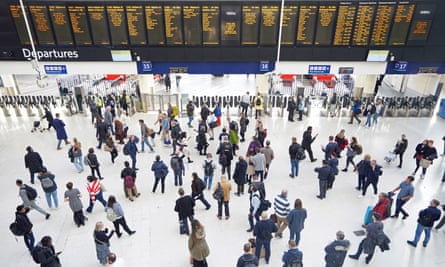Wifi for train passengers in England may be axed as the government seeks to cut costs. The move is being pushed by the Department for Transport in order to cut costs as it looks to “reform all aspects of the railway” and provide “value for money”. But how does it work, and will this prove a false economy?
How does onboard wifi work?
Most train wifi ultimately depends on the broader mobile communications network. The train’s antennae pick up the signal – usually 3G or 4G – from regular masts or base stations near the tracks and connects passengers via routers in carriages.
Establishing a wifi connection is straightforward on most trains. However, the actual speed or connectivity to the internet depends on the network signal and how the bandwidth is divided up between how many users.
Can’t people just use their phone data?
That is what the DfT seems to be hoping. But there are several practical reasons why this does not work.
While train wifi and phones are affected by patchy network coverage – particularly in rural areas – train antennae outside the metal carriages usually perform far better, and in places can connect via networks in tunnels or to station wifi.
Aggregating the demand through one connection or gateway to the train should work better for more people overall, with train wifi systems working to maximise and smooth connectivity from different mobile networks, satellite or wifi. While a growing number of people have access to modern smartphones with unlimited data packages, many still prefer or need wifi.
How long have passenger trains in Britain had wifi?
Long-distance operators provided basic, paid-for wifi as early as 2004, and franchisees were even fined for failing to install it on trains in 2010. Faster and free wifi was rolled out across most trains after 2014, using a £50m fine levied on Network Rail for poor performance. In 2017, the government said it was launching the next phase – of fast-enough 5G connectivity on trains to allow passengers to stream movies, to make journeys “enjoyable and productive … and deliver economic benefits for the whole of the UK”, along with installing trackside masts to boost signals to trains. In practice, installing bespoke trackside communications infrastructure has proved too costly and complex for most of the railway.
So what has changed?
Covid and changing travel patterns have led to a decline in rail passenger numbers and revenue, and the Treasury has demanded that train operators make huge cuts to costs to cover the shortfall. Although passenger numbers are recovering fast, the pressure to find short-term savings has been maintained, particularly while negotiations continue over pay and jobs.

How would axing wifi cut costs for the government?
Since the collapse of the rail franchising system, revenue and most costs are directly on the government’s balance sheet rather than the train operators – and the Treasury in particular is widely seen as wanting to reduce cost rather than invest to attract more custom. Network data is one cost, while a future switch to 5G will also be more costly than the simple upgrade from 3G to 4G using equipment already installed.
Data contracts are not disclosed. Industry experts estimate the bill to be a maximum of £5m a year for the biggest companies but far smaller for most – and those contracts cover data that trains require for operating essentials, even if about 60% is used for passenger wifi. Those data contracts now go beyond the basics of staff communications and payment systems to the kind of maintenance regimes the industry hopes to introduce, from telematics on trains to video imaging of infrastructure and trackside vegetation. In that context, it is unclear how much money cutting passenger wifi services would actually save.
The fear among passenger groups and train operators is that cutting passenger wifi will further dissuade people from using the railways just as their fares are needed.

